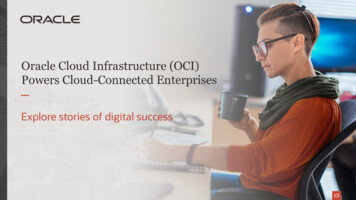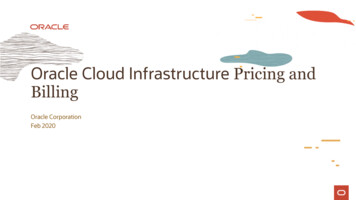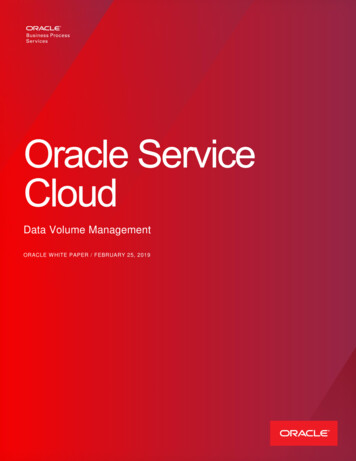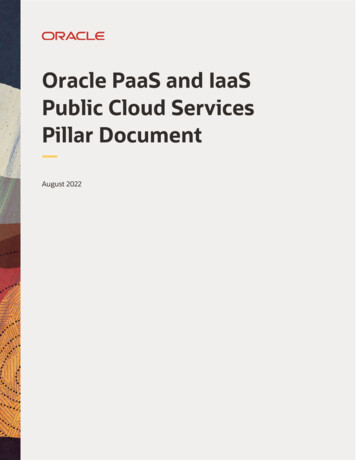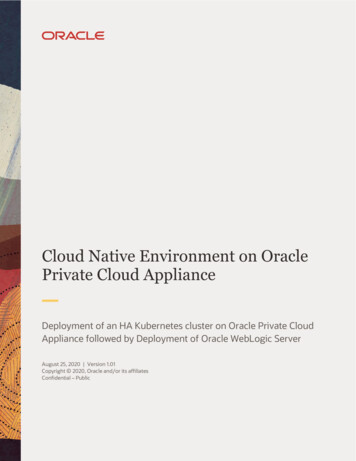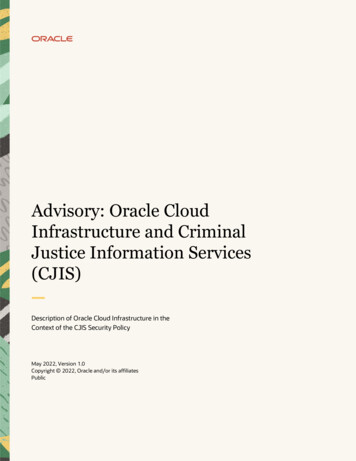
Transcription
Business / Technical BriefAdvisory: Oracle CloudInfrastructure and CriminalJustice Information Services(CJIS)Description of Oracle Cloud Infrastructure in theContext of the CJIS Security PolicyMay 2022, Version 1.0Copyright 2022, Oracle and/or its affiliatesPublic1Advisory: Oracle Cloud Infrastructure and Criminal Justice Information Services (CJIS) / version 1.0Copyright 2022, Oracle and/or its affiliates / Public
DisclaimerThis document in any form, software or printed matter, contains proprietary information that is the exclusive propertyof Oracle. This document is not part of your agreement, nor can it be incorporated into any contractual agreementwith Oracle or its subsidiaries or affiliates.This document is for informational purposes only and is intended solely to assist you assessing your use of OracleCloud services in the context of the requirements applicable to you under the Criminal Justice Information Services(CJIS) Security Policy. This document might also help you to assess Oracle as an outsourced service provider. Youremain responsible for making your own independent assessment of the information in this document, which is notintended as and may not be used as legal advice about the content, interpretation, or application of laws, regulations,and regulatory guidelines. You should seek independent legal advice regarding the applicability and requirements oflaws and regulations discussed in this document.This document does not make any commitment to deliver any material, code, or functionality, and should not berelied on in making purchasing decisions. The development, release, and timing of any features or functionalitydescribed in this document remains at the sole discretion of Oracle.The CJIS Security Policy is subject to periodic changes or revisions by the US Department of Justice, Federal Bureau ofInvestigation, Criminal Justice Information Services Division. The current version, 5.9, is available rce-center.This document is based on information available at the time of drafting. It is subject to change at the sole discretion ofOracle Corporation and might not always reflect changes in the regulations.2Advisory: Oracle Cloud Infrastructure and Criminal Justice Information Services (CJIS) / version 1.0Copyright 2022, Oracle and/or its affiliates / Public
Table of ContentsIntroduction4Document Purpose4About Oracle Cloud Infrastructure4The Cloud Shared Management Model5Criminal Justice Information and CJIS Security Policy5Rules for Federal Data and Oracle Standards5Relationship of CJIS, NIST 800-53, and FedRAMP6Oracle Cloud Infrastructure and FedRAMP6Summary of the CJIS Security PolicyPolicy Area 1: Information Exchange Agreements7Policy Area 2: Security Awareness Training7Policy Area 3: Incident Response7Policy Area 4: Auditing and Accountability8Policy Area 5: Access Control8Policy Area 6: Identification and Authentication9Policy Area 7: Configuration Management9Policy Area 8: Media Protection10Policy Area 9: Physical Protection11Policy Area 10: System and Communications Protection and Information Integrity11Policy Area 11: Formal Audits12Policy Area 12: Personnel Security12Policy Area 13: Mobile Devices12Conclusion36Advisory: Oracle Cloud Infrastructure and Criminal Justice Information Services (CJIS) / version 1.0Copyright 2022, Oracle and/or its affiliates / Public13
IntroductionThe US Federal Bureau of Investigations (FBI) Criminal Justice Information Services Division (CJIS) sets standards forinformation, security, guidelines, and agreements for protecting Criminal Justice Information (CJI). The CJIS SecurityPolicy originated within the FBI as a standard for the exchange and protection of investigatory and criminal justicedata. Rather than mandate a federal standard, the FBI published their work as a policy that can be agreed to at thestate, county, or city level, and by other operating partners and organizations. As a result, each law enforcement andcriminal justice agency can interpret the policy requirements within the context of their own operations, and reducerisk and increase assurance of confidentiality and data protection.The CJIS Security Policy is maintained by the FBI and provided for use by any organization handling CJI. The currentversion is 5.9 and is published at e-center.Document PurposeThis document is intended to provide relevant information related to Oracle Cloud Infrastructure (OCI) to assist you indetermining the suitability of using OCI US Government Cloud in relation to the 13 policy areas of the CJIS SecurityPolicy. This document describes Oracle practices and OCI services that might help you meet the requirements of theCJIS Security Policy. We provide you with links to public-facing resources to help you implement those capabilities inyour efforts to meet your CJIS Security Policy requirements.Note: This document focuses on technical security controls. CJIS might have additional policy requirements that are notcovered here.The information contained in this document does not constitute legal advice. Customers are advised to seek theirown legal counsel to develop and implement their compliance program and to assess the features and functionalityprovided by Oracle in regard to their specific legal and regulatory requirements.About Oracle Cloud InfrastructureOracle’s mission is to help customers see data in new ways, discover insights, and unlock possibilities. Oracle providesseveral cloud solutions tailored to customers’ needs. These solutions provide the benefits of the cloud, includingglobal, secure, and high-performance environments in which to run all your workloads. The cloud offerings discussedin this document include Oracle Cloud Infrastructure (OCI).OCI is a set of complementary cloud services that enable you to build and run a wide range of applications andservices in a highly available and secure hosted environment. OCI offers high-performance computing capabilitiesand storage capacity in a flexible overlay virtual network that is easily accessible from an on-premises network. OCIalso delivers high-performance computing power to run cloud native and enterprise IT workloads. For moreinformation about OCI, see docs.oracle.com/iaas/Content/home.htm.OCI US Government Cloud regions offer a highly secure, enterprise-scale cloud ecosystem that is isolated fromcommercial customers and built to support mission-critical public sector workloads. The OCI US Government Cloudregions are for the exclusive use of US public sector workloads and select commercial entities who support USgovernment customers. For more information about Oracle Cloud for Government, sory: Oracle Cloud Infrastructure and Criminal Justice Information Services (CJIS) / version 1.0Copyright 2022, Oracle and/or its affiliates / Public
The Cloud Shared Management ModelFrom a security management perspective, cloud computing is different from on-premises computing. On-premisescustomers have full control of their technology infrastructure. For example, they have physical control of thehardware and full control over the technology stack in production. In the cloud, however, customers use componentsthat are partially under the management of the cloud service providers. As a result, the management of security in thecloud is a shared responsibility between the cloud customers and the cloud service provider.Oracle provides best-in-class security technology and operational processes to secure enterprise cloud services.However, customers must also be aware of and manage their security and compliance responsibilities when runningtheir workloads in Oracle cloud services. By design, Oracle provides security functions for cloud infrastructure andoperations, such as cloud operator access controls and infrastructure security patching. Customers are responsiblefor securely configuring and using their cloud resources. For more information, seedocs.oracle.com/iaas/Content/home.htm.The following figure illustrates this division of responsibility at a high level.Figure 1: Conceptual Representation of the Various Security Management Responsibilities Between Customers and Cloud ProvidersCriminal Justice Information and CJIS Security PolicyCriminal Justice Information (CJI) is the data that law enforcement, national security, and intelligence communitypartners need to perform their mission and enforce laws. This information includes but is not limited to biometric,identity history, person, organization, property, and case/incident history data. A Criminal Justice Information Systemis any application, system, network, or the underlying infrastructure that manages, stores, transmits, or otherwise isinvolved in the handling of CJI within or between authorized agencies and organizations.Rules for Federal Data and Oracle StandardsThe foundation for CJIS is National Institute of Standards and Technology (NIST) Special Publication (SP) 800-53r5, astandard that defines a catalog of controls for a complete information security management system. NIST 800-53r5establishes security and privacy controls for information systems and organizations and provides a common baselinefor a complete information security program. The Federal Information Security Modernization Act (FISMA) islegislation that provides information about how to design a security program for risk, tailoring it for specific uses. The5Advisory: Oracle Cloud Infrastructure and Criminal Justice Information Services (CJIS) / version 1.0Copyright 2022, Oracle and/or its affiliates / Public
FISMA standards denote the “high, moderate, or low impact” scale on which federal risk evaluation is based. Anorganization uses this scale to set a baseline for the design and implementation of an information security program.Relationship of CJIS, NIST 800-53, and FedRAMPThe FBI puts forth the frameworks from FISMA and NIST 800-53r5 as the foundation for protection of federal CJI. FBIpartner agencies use the impact labels and organization of security controls from the NIST 800-53r5 standard. TheCJIS Security Policy supports and promotes interoperation and exchange of data. Many public agencies throughoutthe US base their own security standards and policies on this same framework because it provides consistency amongstates and entities requiring CJIS Security Policy adherence.Federal Risk and Authorization Management Program (FedRAMP) is a federal government program that provides arepeatable process for certifying NIST- and FISMA-compliant cloud solutions. When one federal agency sponsors acloud provider through the audit process, FedRAMP provides a process by which other agencies may accept thecertification and acquire services quickly, rather than repeat the same audit process for themselves.Oracle Cloud Infrastructure and FedRAMPOCI’s US Government Cloud has been assessed by an independent third party and achieved FedRAMP HighProvisional Authority to Operate (P-ATO). For the complete list of OCI US Government Cloud services that haveachieved authorization, see marketplace.fedramp.gov. OCI has been assessed to meet the requirement for NIST 80053r5 controls, plus additional controls to support “high impact” data categories, which include the government’s mostsensitive unclassified data.OCI has been assessed to meet the requirements for these standards and further undergoes regular audits to provideassurance that its security program and its supporting controls are operating effectively. OCI services and thesupporting components undergo continual updates, testing, validation, and reporting within both internal andexternal compliance frameworks. For more information, see oracle.com/corporate/cloud-compliance.Summary of the CJIS Security PolicySections 1 and 2 of the CJIS Security Policy address introductory material and the compliance approach. Section 3provides a definition and examples of roles and responsibilities based on a shared management philosophy betweenagencies that handle CJI data. This shared management philosophy matches the shared management modelimplemented by Oracle. Section 4 provides definitions of CJI and personally identifiable information (PII).The formal policy requirements of CJIS are presented in Section 5, “Policy and Implementation.” Each of the 13 policyareas is a subsection of Section 5. (In various official documents, these subsections are described both with andwithout the leading number; for example, Policy Area 3 is described as “Section 5.3” or “part 3” interchangeably.) Thisdocument evaluates each of the 13 policy areas described in Section 5 and describes OCI operational and securitypractices and applicable services in the context of each requirement.Customers are solely responsible for determining the suitability of a cloud service in the context of the CJIS SecurityPolicy requirements. Therefore, they are responsible for ensuring that their use of the cloud service and businessprocesses meet these requirements.6Advisory: Oracle Cloud Infrastructure and Criminal Justice Information Services (CJIS) / version 1.0Copyright 2022, Oracle and/or its affiliates / Public
Policy Area 1: Information Exchange Agreements“The information shared through communication mediums shall be protected with appropriate security safeguards.The agreements established by entities sharing information across systems and communication mediums are vitalto ensuring all parties fully understand and agree to a set of security standards.” (CJIS, 2020)As a cloud provider, Oracle generally has no insight into the data stored or processed in OCI, or whether that data isCJI. However, the contractual rights and obligations of each party are established through contract documents, whichthe customer and Oracle sign before the provision of cloud services. The Data Processing Agreement for OracleServices covers key data privacy requirements for service engagements. For more information, ontracts.html.OCI provides the following services and features that might help you meet this requirement for information exchangeagreements: Data Safe is a fully integrated cloud service focused on data security. It provides a complete and integratedset of features for protecting sensitive and regulated data in Oracle Cloud databases. For more information,see docs.oracle.com/iaas/data-safe/index.html. Identity and Access Management (IAM) lets you control who has access to your organization’s cloudresources. You can control what type of access a group of users has and to which specific resources. Formore information, see rview.htm.Policy Area 2: Security Awareness Training“Security training is key to the human element of information security. All users with authorized access to CJIshould be made aware of their individual responsibilities and expected to behavior when accessing CJI and thesystems which process CJI. LASOs require enhanced training on the specific duties and responsibilities of thosepositions and the impact those positions have on the overall security of information systems.” (CJIS, 2020)As a cloud provider, Oracle generally has no insight into the data stored or processed in OCI, or whether that data isCJI. The customer is responsible for implementing a security awareness program to meet the requirements of PolicyArea 2.OCI employees are required to complete security awareness training when they are hired and annually thereafter. Thecourse instructs employees on their obligations under Oracle privacy and security policies for the management of OCIsystems. This course also covers data-privacy principles and data-handling practices. For more information, te/human-resources-security.html.Policy Area 3: Incident Response“The security risk of both accidental and malicious attacks against government and private agencies, remainspersistent in both physical and logical environments. To ensure protection of CJI, agencies shall: (i) establishoperational incidental handling procedures that include adequate preparation, detection, analysis, containment,recovery, and user response activities; (ii) track, document, and report incidents to appropriate agency officialsand/or authorities.” (CJIS, 2020)Customers are solely responsible for implementing incident response plans for their environment and meetingapplicable requirements to ensure protection of CJI.OCI provides the Cloud Guard service, which might help you meet this requirement for incident response. CloudGuard helps customers monitor, identify, achieve, and maintain a strong security posture on Oracle Cloud. Use theservice to examine OCI resources for security weaknesses related to configuration, and to examine OCI operators andusers for risky activities. Upon detection, Cloud Guard can suggest, assist, or take corrective actions, based on how itis configured. For more information, see y: Oracle Cloud Infrastructure and Criminal Justice Information Services (CJIS) / version 1.0Copyright 2022, Oracle and/or its affiliates / Public
The Data Processing Agreement for Oracle Services describes Oracle’s practices in the event of an incident orpersonal information breach. The Data Processing Agreement is available at acts.html.Policy Area 4: Auditing and Accountability“Agencies shall implement audit and accountability controls to increase the probability of authorized usersconforming to a prescribed pattern of behavior. Agencies shall carefully assess the inventory of components thatcompose their information systems to determine which security controls are applicable to the various components.“Auditing controls are typically applied to the components of an information system that provide auditingcapability (servers, etc.) and would not necessarily be applied to every user-level workstation within the agency. Astechnology advances, more powerful and diverse functionality can be found in such devices as personal digitalassistants and cellular telephones, which may require the application of security controls in accordance with anagency assessment of risk.” (CJIS, 2020)Customers are solely responsible for determining the suitability of a cloud service in the context of this requirement.Therefore, you are responsible for ensuring that your organization’s use of the cloud service and business processesmeet these requirements.OCI provides the following services and features that might help you meet this requirement for auditing andaccountability: The Audit service provides visibility into activities related to OCI resources and tenancy. Audit log events canbe used for security audits, to track use of and changes to OCI resources, and to help ensure compliance withstandards or regulations. For more information, see docs.oracle.com/iaas/Content/Audit/home.htm. Data Catalog helps consumers easily find, understand, govern, and track Oracle Cloud data assets. For moreinformation, see docs.oracle.com/iaas/data-catalog/home.htm. Identity and Access Management (IAM) lets you control who has access to cloud resources. You cancontrol what type of access a group of users has and to which specific resources. For more information, overview.htm. Logging Analytics is a cloud solution in OCI that lets you index, enrich, aggregate, explore, search, analyze,correlate, visualize, and monitor all log data from applications and system infrastructure. For moreinformation, see Policy Area 5: Access Control“Access control provides the planning and implementation of mechanisms to restrict reading, writing, processingand transmission of CJIS information and the modification of information systems, applications, services andcommunication configuration allowing access to CJIS information.” (CJIS, 2020)Customers are solely responsible for determining the suitability of a cloud service in the context of this requirement.Therefore, you are responsible for ensuring that your organization’s use of the cloud service and business processesmeet these requirements.OCI provides the following services and features that might help you meet this requirement for access control: 8Identity and Access Management (IAM) lets you control who has access to your cloud resources. You cancontrol what type of access a group of users has and to which specific resources. For more information, overview.htm.Advisory: Oracle Cloud Infrastructure and Criminal Justice Information Services (CJIS) / version 1.0Copyright 2022, Oracle and/or its affiliates / Public
The Vault key management service provides centralized management of the encryption of customer datawith keys that you control. For more information, epts/keyoverview.htm.Oracle creates a tenancy for each customer, which is a secure and isolated partition within OCI where customers cancreate, organize, and administer their cloud resources. Customer isolation allows customers to deploy theirapplication and data assets in an environment that commits full isolation from other tenants and Oracle staff.Policy Area 6: Identification and Authentication“The agency shall identify information system users and processes acting on behalf of users and authenticate theidentities of those users or processes as a prerequisite to allowing access to agency information systems orservices.” (CJIS, 2020)Customers are solely responsible for determining the suitability of a cloud service in the context of this requirement.Therefore, you are responsible for ensuring that your organization’s use of the cloud service and business processesmeet these requirements.OCI provides the Identity and Access Management (IAM) service, which might help you meet this requirement foridentification and authentication. IAM lets you control who has access to your cloud resources. You can control whattype of access a group of users has and to which specific resources. For more information, overview.htm.Oracle manages its access to the infrastructure and the services supporting OCI by implementing controls that requiremultifactor authentication (MFA), a VPN connection, and an SSH connection with a user account and a password orprivate key.Policy Area 7: Configuration Management5.7.1: Access Restrictions for Changes“Planned or unplanned changes to the hardware, software, and/or firmware components of the informationsystem can have significant effects on the overall security of the system. The goal is to allow only qualified andauthorized individuals access to information system components for purposes of initiating changes, includingupgrades, and modifications.” (CJIS, 2020)The customer is responsible for implementing least privilege functionality, and for security of CJI, software, andsystem configuration documentation as defined by Policy Area 7.OCI provides the following services and features that might help you meet this requirement for access restrictions forchanges: Identity and Access Management (IAM) lets you control who has access to your cloud resources. You cancontrol what type of access a group of users has and to which specific resources. For more information, overview.htm. Compartments let you organize and isolate resources to make it easier to manage and secure access tothem. For more information, agingcompartments.htm.Oracle has formal change management practices that are generally described sting-delivery-policies.html.9Advisory: Oracle Cloud Infrastructure and Criminal Justice Information Services (CJIS) / version 1.0Copyright 2022, Oracle and/or its affiliates / Public
Oracle also employs standardized system-hardening practices across the OCI devices that it manages. Thesepractices include the following ones: Alignment monitoring with base images, baselines, or both Restricting protocol access Removing or disabling unnecessary software and services Removing unnecessary user accounts Patch management and logging capabilitiesFor more information, see cy Area 8: Media Protection“Media protection policy and procedures shall be documented and implemented to ensure that access to digitaland physical media in all forms is restricted to authorized individuals. Procedures shall be defined for securelyhandling, transporting and storing media.” (CJIS, 2020)Customers are responsible for direct CJI data storage, including physical media in its own environment and digitalstorage media virtualized in cloud infrastructure. Customers are responsible for data deletion and sanitization whenvirtual containers for CJI remain in service for reuse or repurposing.OCI provides the following services and features that might help you meet this requirement for media protection: Object Storage lets you store unstructured data of many content types. This regional service stores dataredundantly across multiple storage servers and multiple availability domains. It actively monitors andprovides data redundancy. If a redundancy loss is detected, Object Storage automatically creates more datacopies. For more information, jectstorageoverview.htm. Archive Storage is a storage class tier for data objects that must be retained for long periods of time but arerarely accessed. For more information, rchivestorageoverview.htm. Block Volume lets you use a block volume as a regular hard drive when it’s attached and connected to aCompute instance. Volumes are automatically replicated to help protect against data loss. For moreinformation, see ew.htm. File Storage lets you manage shared file systems and mount targets, and create file system snapshots. FileStorage uses synchronous replication and high-availability failover for resilient data protection. For moreinformation, see rageoverview.htm.OCI secures the media used for the underlying cloud infrastructure that it manages. OCI does not transport mediathat contains customer data. Oracle’s encryption and encoding controls prevent OCI from having visibility intocustomer data or the virtual containers in which it is stored and managed. Inoperable or decommissioned equipmentis sanitized before disposal. For more information about media management at Oracle, te/data-protection/technical-controls.html.10 Advisory: Oracle Cloud Infrastructure and Criminal Justice Information Services (CJIS) / version 1.0Copyright 2022, Oracle and/or its affiliates / Public
Policy Area 9: Physical Protection“Physical protection policy and procedures shall be documented and implemented to ensure CJI and informationsystem hardware, software, and media are physically protected through access controls measures.” (CJIS, 2020)Customers are responsible for all aspects of the direct physical protection of CJI. This protection includes access tocustomer facilities and locations where it operates its business, and controlled areas where CJI is accessed,transmitted, or displayed to individuals.Oracle Cloud data centers are designed to help protect the security and availability of customer data. This approachbegins with Oracle’s site selection process. Candidate build sites and provider locations undergo an extensive riskevaluation by Oracle. This evaluation considers environmental threats, power availability and stability, vendorreputation and history, neighboring facility functions (for example, high-risk manufacturing or high-threat targets),and geopolitical considerations, among other criteria.Oracle Cloud data centers align with Uptime Institute and Telecommunications Industry Association (TIA) ANSI/TIA942-A Tier 3 or Tier 4 standards and follow an N2 redundancy methodology for critical equipment operation. Datacenters that house OCI services use redundant power sources and maintain generator backups in case of widespreadelectrical outage. Server rooms are closely monitored for air temperature and humidity, and fire-suppression systemsare in place. Data center staff are trained in incident response and escalation procedures to address security andavailability events that might arise.Policy Area 10: System and Communications Protection and Information Integrity“Examples of systems and communications safeguards range from boundary and transmission protection tosecuring an agency’s virtualized environment. In addition, applications, services, or information systems musthave the capability to ensure system integrity through the detection and protection against unauthorized changesto software and information.” (CJIS, 2020)Customers are solely responsible for determining the suitability of a cloud service in the context of this requirement.Therefore, you are responsible for ensuring that your organization’s use of the cloud service and business processesmeet these requirements.The following OCI services enable at-rest data encryption by default, by using the Advanced Encryption Standard(AES) algorithm with 256-bit encryption. In-transit control plane data is encrypted by using Transport Layer Security(TLS) 1.2 or later. You can use these services and features to help meet the encryption requirements: Object Storage lets you store unstructured data of many content types. This regional servi
Title: Advisory: Oracle Cloud Infrastructure and Criminal Justice Information Services (CJIS) Author: Oracle Corporation Subject: Provides relevant information related to Oracle Cloud Infrastructure (OCI) to assist you in determining the suitability of using OCI US Government Cloud in relation to the 13 policy areas of the Criminal Justice Information Services Division (CJIS) Se curity Policy.
